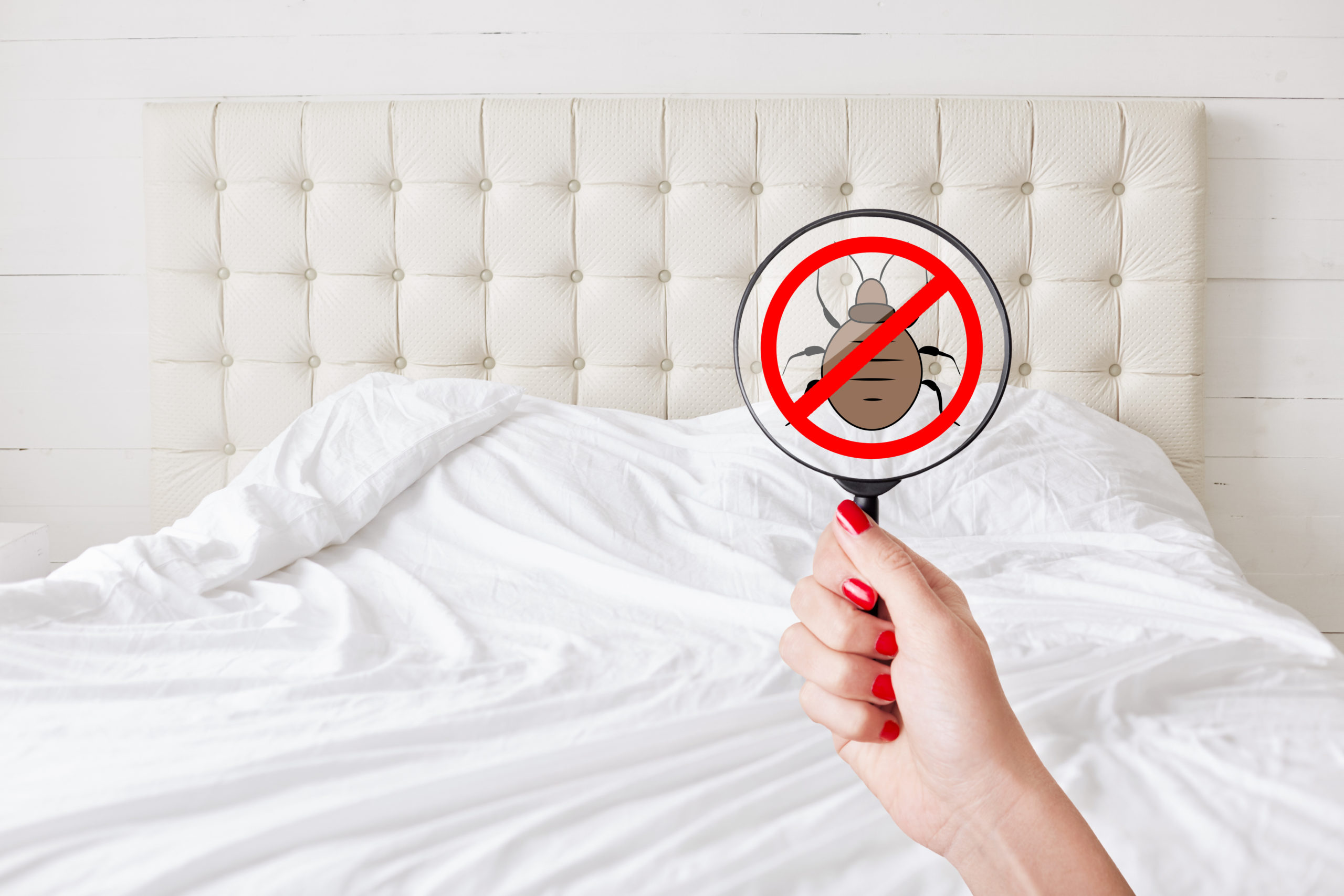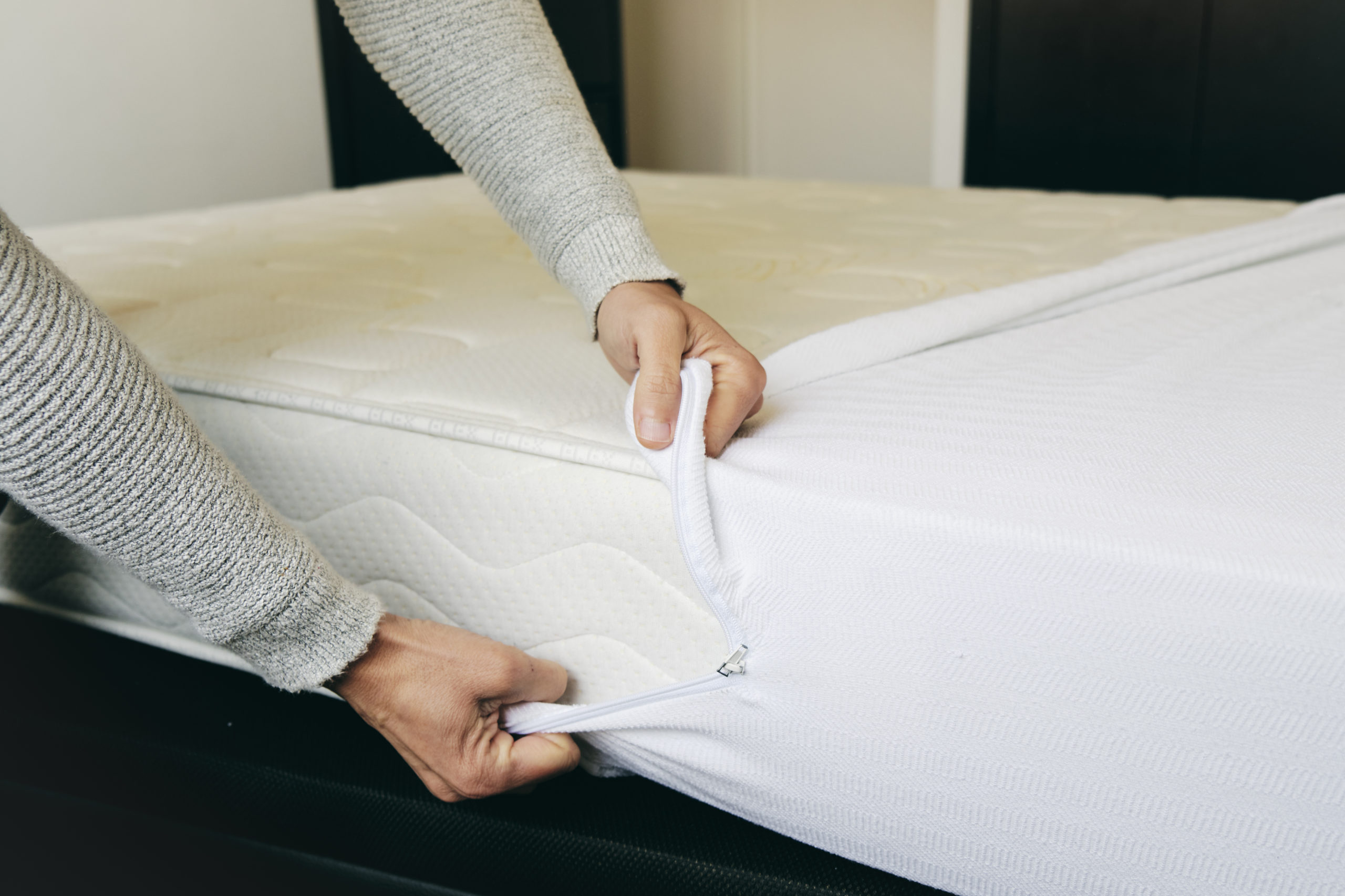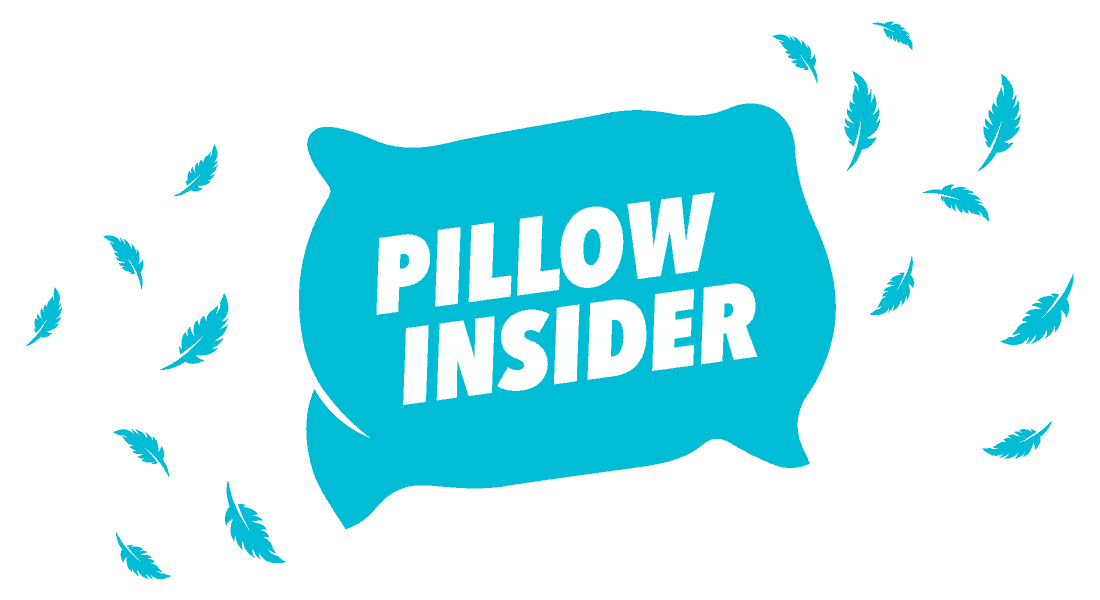When tucking you in at night, did your parents tell you to sleep tight and not let the bed bugs bite? If you’re lucky, this cute bedtime rhyme is as close as you’ll get to bed bugs. Unfortunately, bed bugs are common, and it doesn’t take much for them to spread.
In fact, a single pregnant female bed bug can infest your entire home with over 300 adult bed bugs and more than 1,000 new eggs in just three months.

Bed bugs are tiny little insects, but their impact is huge. Female bed bugs lay hundreds of eggs, each only about the size of a speck of dust. Under the right conditions, immature bed bugs called nymphs can become fully developed in a month and can produce three or more generations within the next twelve. While bed bugs may not transmit disease, they can be quite a nuisance. These insects feed on blood and, in most cases, you and your family will become their favorite meal.
Keeping bed bugs out of your house is the best way to avoid infestation as it seems obvious. More than that, however, you want to reduce or eliminate places where they can hide which includes your mattress. A bed bug mattress protector is an inexpensive investment in a bed bug-free future.
Read on to learn more about protecting your mattress (and your home) from bed bugs and to see our top picks for the best bed bug mattress protector.
What are the Best Mattress Protectors for Bed Bugs?
- Best Overall: SafeRest
- Best Premium: Plush Deluxe
- Best Hypoallergenic: Luna
- Best Waterproof: UltraPlush
- Best Budget-Friendly: Linenspa
Do You Have Bed Bugs?
Bed bugs tend to be most active at night, so you may not actually see them until you start looking for them. The first sign of bed bugs for many people is the appearance of small bites or itchy welts around the ankles and other areas of exposed skin. If you wake up covered in tiny bites, it’s time to take a closer look for other signs of bed bug infestation.
Here are some other signs you may have bed bugs:
- Blood stains on your sheets, pillows, and other bedding
- Dark or rusty stains (bed bug excrement) on bedding and walls
- Discarded eggshells or shed skins in hiding places
- An offensive, musty odor (like a wet towel) in bedrooms
When looking for bed bugs, start with your bedding. Look for the telltale reddish-brown spots along the corners and seams of your bedding. Check other upholstered furniture and look behind dressers and behind the headboard as well. Don’t forget to check the clothing in your closet.
If you’re concerned you may have a bed bug infestation, but you aren’t sure, it’s worth hiring a professional to come take a look. You can probably even get a free consultation. Even if you end up having to pay for it, you’ll be glad to know you either don’t have an infestation or, if you do, that you can start taking steps to treat it sooner rather than later.
Tips for Treating and Preventing Bed Bugs
Bed bugs are excellent hitchhikers. They can travel from an invested site to your home in anything from furniture and bedding to clothing and luggage. Bed bugs typically feed every 5 to 10 days and will often die if they don’t have access to blood, but they can be surprisingly resilient in some cases and may persist for months at a time. Your best bet is to keep them out of your home to start with.
Here are some simple tips for preventing bed bugs:
- Always check secondhand clothing, furniture, and bedding before bringing it home
- Reduce clutter in your home to minimize hiding places for bed bugs
- Vacuum frequently, especially in bedrooms and other areas with upholstered furniture
- Always be vigilant when using shared laundry facilities, transport clothing in plastic bags
- Encase your mattress and box spring with a zippered cover to keep out bed bugs
If you’re unlucky enough to already have a bed bug infestation, your efforts should shift toward elimination. The only way to confirm a bed bug infestation is to see the bed bugs yourself (or to hire a professional to come in and do it). Once you’ve identified them, you can start eradicating them.
Here are the steps you’ll need to take to make your home bed bug-free:
- Remove and clean all bedding, linens, and clothing in hot water and dry with heat
- Place all items that can’t be washed in the dryer for 30 minutes on high
- Use a stiff brush to scrub the mattress and upholstered furniture before vacuuming
- Vacuum the bed and surrounding area frequently, dispose of bag in plastic outdoors
- Encase the mattress and box spring with a tightly woven zippered cover
- Repair all cracks in walls and flooring, reduce clutter to eliminate hiding places
Once you’ve gotten your bed bug infestation under control, you want to do everything you can to avoid having to do it again in the future. Read on to learn how a bed bug mattress protector might help.
Should You Get a Mattress Protector?
Your bed is the best place for bed bugs to hide as no surprise there. That means the most effective way to prevent bed bug infestations from taking hold is to eliminate your bed as a hiding place. Enclosing your mattress and box spring in a bed bug mattress cover is the way to go. These products are technically called mattress encasements because they are designed to wrap all the way around the mattress and box spring, typically using a zipper closure.
Here’s what you should look for in the best bed bug mattress cover:
- Make sure it completely encloses the mattress and box spring rather than just covering the top and sides
- Check the label for the words “bed bug proof” to make sure it’s actually designed for bed bugs
- Look for certifications, recommendations, or approval from reputable pest control companies
- Research the brand name to see if they’ve conducted studies on the efficacy of the product
- Read online reviews and testimonials from people who have actually tried the product
- Avoid shopping by price alone as cheap products aren’t always made with high-quality materials
By now you have a pretty good idea why you should care about preventing bed bugs. Using mattress covers to protect the beds in your home is a simple but important step in that direction. Read on to see our top picks for the best bed bug mattress protectors.
The Best Mattress Protector for Bed Bugs
Though a mattress protector is only one piece of the puzzle in treating or preventing bed bug infestations, it is an important one. Finding the best mattress encasement doesn’t need to be challenging and you simply need to know the basics of what you’re looking for.
We’ve done our best to provide you with a wide range of options to help you narrow down your pick. Here are our top choices for the best mattress protector for bed bugs:
SafeRest
Best Overall: Protection against bed bugs will help you sleep at night, but not if your mattress protector crinkles every time you move. If you’re looking for a noiseless mattress cover, we recommend SafeRest. The SafeRest Premium Hypoallergenic Waterproof Mattress Protector delivers 360-degree protection for mattresses of all sizes ranging from twin to California king, 6 to 18 inches deep.
The SafeRest mattress protector is made from high-quality materials in the USA and is independently lab-tested and certified bed bug proof. This mattress cover is breathable, noiseless, and hypoallergenic thanks to a secure micro zipper and a combination of hypoallergenic cotton with a breathable membrane backing. The cover protects against bed bugs, allergens, dust mites, perspiration, bacteria, urine, and more and comes with a 10-year warranty.
If you’re looking for a premium mattress protector that is certified effective and safe for your family, try the SafeRest Premium Hypoallergenic Waterproof Mattress Protector.
[maxbutton id=”1″ url=”https://www.amazon.com/dp/B003PWNH4Q?th=1&linkCode=ll1&tag=pillowinsider01-20&linkId=053bbd56a1d60adfa9163718ef8e5c69&language=en_US&ref_=as_li_ss_tl” text=”Buy at Amazon” window=”new” nofollow=”true” ]
PlushDeluxe
Best Premium: When you want the best of the best, PlushDeluxe is the way to go. This premium mattress encasement is soft and breathable but still delivers hypoallergenic protection from bed bugs as well as all kinds of liquid. This zippered mattress encasement protects your mattress on all six sides, guarding against everything from water and wine to perspiration and bedwetting.
The PlushDeluxe Premium Mattress Encasement features a fine invisible zipper with a secure Velcro strap to keep your mattress fully protected. It is machine washable and easy to clean, plus it has a soft cotton terry surface for comfort. This encasement won’t change the feel of your mattress and it is noiseless as well. It fits mattresses ranging from twin to California king, 9 to 12 inches thick.
In addition to protecting against bed bugs, the PlushDeluxe Premium Mattress Encasement helps keep out dust mites, bacteria, and other allergens. This makes it a great choice for people with sensitive skin and skin conditions like eczema as well.
[maxbutton id=”1″ url=”https://www.amazon.com/gp/product/B06XR2888X?ie=UTF8&linkCode=ll1&tag=pillowinsider01-20&linkId=1229af90dbd7287579da301a3cef2633&language=en_US&ref_=as_li_ss_tl” text=”Buy at Amazon” window=”new” nofollow=”true” ]
Luna
Best Hypoallergenic: If you’re going to buy a mattress protector, you want to make sure it protects against more than just bed bugs. Allergens like dust mites can build up in your mattress, irritating your skin and aggravating your respiratory system. A hypoallergenic mattress cover is the way to go, but you need to make sure it does both: protects against bed bugs AND allergens. The Luna Premium Hypoallergenic Waterproof Mattress Protector does.
The Luna is made from stretchable premium bottom terry that secures the mattress 360-degrees around. This mattress cover is waterproof against spills and machine washable for convenience. To give you peace of mind, the Luna Airflow Technology allows air to circulate through the protector, but repels liquids, and it is surprisingly durable despite being stretchy.
The Luna is moderately priced and, it’s sold from a twin size through California king.
[maxbutton id=”1″ url=”https://www.amazon.com/dp/B002AQNXR4?th=1&linkCode=ll1&tag=pillowinsider01-20&linkId=e2b11f39d655211551562e821960b7f5&language=en_US&ref_=as_li_ss_tl” text=”Buy at Amazon” window=”new” nofollow=”true” ]
UltraPlush
Best Waterproof: Bed bud prevention is your primary concern, but you want a mattress cover that does double duty. A waterproof mattress cover is well worth the investment, because you never know when accidents are going to happen. Whether you’re sipping water in the middle of the night or watching a movie with a glass of wine, you want to know that a simple spill isn’t going to ruin your mattress.
The UltraPlush Waterproof Mattress Protector is 100% waterproof and made from cotton to ensure comfort and quality. The odor-free mattress cover does not contain PVC’s, phthalates, or vinyl. The waterproof mattress protector has also beat the 100 gallon flood test to prove its resilience to liquids and moisture.
Whether you’re shopping for a single mattress protector or buying for the whole family, we recommend the UltraPlush Waterproof Mattress Protector!
[maxbutton id=”1″ url=”https://www.amazon.com/dp/B00CWQJSQW?th=1&linkCode=ll1&tag=pillowinsider01-20&linkId=984cf16a8a9dfa1781da86c31f49768f&language=en_US&ref_=as_li_ss_tl” text=”Buy at Amazon” window=”new” nofollow=”true” ]
Linenspa
Best Budget-Friendly: A good bed bug mattress protector is one that encloses the mattress on all six sides. This is the key to efficacy. The good news is you don’t necessarily have to pay a fortune to find a mattress protector that delivers on this requirement. Personally, we like the Linenspa Zippered Mattress Encasement as an affordable option that comes in a wide range of sizes (including a model specifically for box springs).
The Linenspa Zippered Mattress Encasement comes in sizes ranging from twin to California king, including the twin XL. It fits mattresses up to 12 inches deep and creates a smooth, waterproof barrier to protect against spills. This mattress encasement is made from soft, breathable fabric to deliver a comfortable night’s sleep and it isn’t as noisy as some mattress protectors. It also protects against dust mites and other allergens. Plus, it’s covered by a 10-year warranty.
[maxbutton id=”1″ url=”https://www.amazon.com/gp/product/B00Z06F2OI?ie=UTF8&linkCode=ll1&tag=pillowinsider01-20&linkId=68d2c9318f8bfcd894b2fdaa9d2aa25d&language=en_US&ref_=as_li_ss_tl” text=”Buy at Amazon” window=”new” nofollow=”true” ]

Once you have a bed bug infestation, you’ll be dealing with it for the next month, maybe even the next year or longer. Bed bugs are a stubborn pest, so it’s really better to prevent the problem than to have to worry about treating it. Fortunately, one of the most effective ways to prevent bed bugs is also the simplest and the most affordable. A good mattress encasement will keep bed bugs out of your mattress and box spring, eliminating their number-1 hiding place. If you’re ready to start shopping, check out our top picks for the best mattress protector for bed bugs above.
Frequently Asked Questions
- Do bed bug mattress covers work? Yes, mattress covers for bed bugs work but you have to find the right one. Plastic mattress covers designed to protect against spills are not the same thing and you need what’s called a mattress encasement. A mattress encasement should completely enclose the mattress and box spring, all the way around. It should be made from tightly woven material with a zippered closure to trap the bed bugs inside. Eventually, the bed bugs will starve and the encasement will prevent other bed bugs from getting in and recreating the infestation.
- Can bed bugs go through a plastic mattress cover? Plastic mattress covers are designed to protect the mattress against spills, not against bed bugs. Though bed bugs may not be able to chew through plastic, they may not need to. Many mattress covers designed to protect against spills don’t completely encase the mattress, so bed bugs can simply crawl underneath them. To protect your mattress you need a cover that completely encases the mattress.
- How long do you leave a bed bug mattress protector on? If you’re using a bed bug mattress protector for prevention, there’s really no need to remove it once you place it on the bed. If you’re using it to eliminate an active infestation, however, you’ll need to leave it on for at least a year. Bed bugs typically feed every 5 to 10 days, but they can sometimes go for months without a blood meal. Waiting a full year ensures that both the adult bed bugs and their eggs have died.
- What can I put on my body to repel bed bugs? The best way to deal with a bed bug infestation is a multi-stage approach. You’ll need to clean all linens, clothing, and bedding and eliminate places where bed bugs can hide. A mattress protector will kill bed bugs already living in your mattress, but you may want to protect yourself from bites in the meantime. Products made with essential oils like peppermint, tea tree, and lavender may help.
- Can you have just a few bed bugs? A bed bug infestation can start with just a few bed bugs or a single pregnant female. Though you might start out with “just a few,” however, it won’t stay that way for long. Over its lifetime, a female bed bug lays hundreds of eggs that go on to become reproducing adults themselves. If you want to get the infestation under control, you need to take action at the first sign of a problem. Bed bugs are hard to eradicate completely, so you’ll only make things harder on yourself by procrastinating.





